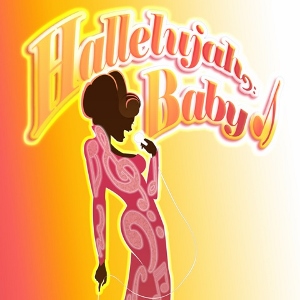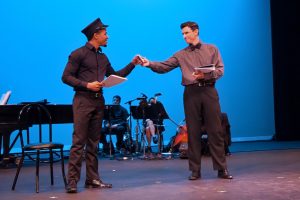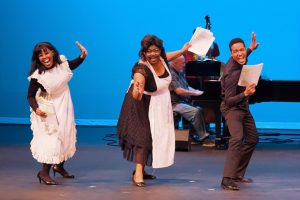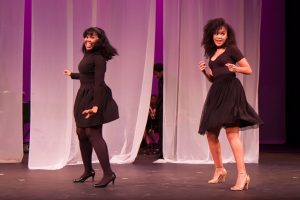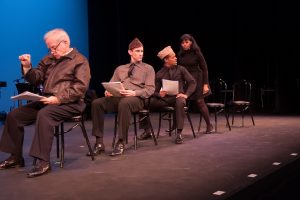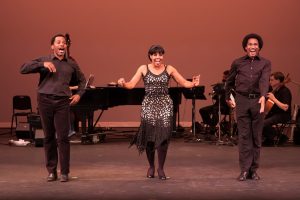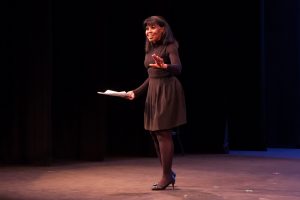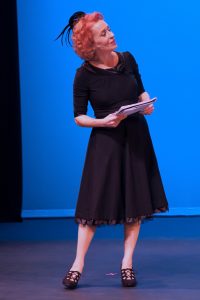COME ON, BABY
I wanted so badly to say “Glory, Hallelujah!” after seeing Musical Theatre Guild’s staged concert version of the 1968 Tony-winning musical. While it’s easy to forgive a lead actress who was not her usual self vocally, the spread-out staging, line screw-ups (and they’re on script!), and minuscule orchestra (five pieces!), I am left to ponder what this group is really all about. I’m eternally grateful as a musical theater history buff to see and hear musicals from start to finish that will never see the light of, um, spotlights, but why go through all the fundraising and committee meetings and volunteer work, etc. etc. and have such a weak presentation? Is their heart not in it anymore? Is it just too much work? And why are there so many empty seats if there’s only one performance?
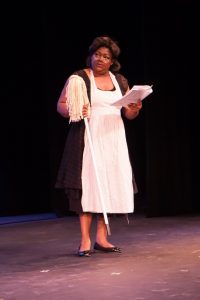 Hallelujah, Baby! opened April 26, 1967 at the Beck Theatre. The creators were all theater royalty: I’ve been listening to the LP for years, and the solidly crafted score by Jule Styne (music) and Betty Comden & Adolph Green (lyrics) has some real good tunes. It turns out that Arthur Laurents’ book is the problem. The show’s modest success (293 performances), came courtesy of a charming newcomer, Leslie Uggams, who made the show a hit (it still closed at a loss, winning the 1968 Tony for Best Musical after it closed.).
Hallelujah, Baby! opened April 26, 1967 at the Beck Theatre. The creators were all theater royalty: I’ve been listening to the LP for years, and the solidly crafted score by Jule Styne (music) and Betty Comden & Adolph Green (lyrics) has some real good tunes. It turns out that Arthur Laurents’ book is the problem. The show’s modest success (293 performances), came courtesy of a charming newcomer, Leslie Uggams, who made the show a hit (it still closed at a loss, winning the 1968 Tony for Best Musical after it closed.).
The musical covers the past 100 years in American civil rights history, following a young African American woman named Georgina from South Carolina in the early 1900s to a successful entertainer about a century later in the White House. As Georgina (played by Sharon Catherine Brown, whose belt really suffered for some reason–a cold?) states at the outset of the show “I’m twenty-five…give or take.” And so, although 100 years passes, all the characters stay the same age with just their situations, costumes, and time periods changing. The first act covers 1900-1940. The second act picks up during World War II and brings us to the current day, which isn’t 1967. At first I was confused that we were into the 1970s, ’80s, ’90s (skimmed over in a few minutes anyway) and the new century (which gets about 120 seconds), but Tom Hatten’s program notes explain that we were seeing Laurents’ 2004 revised version with some updated lyrics by Adolph’s daughter Amanda and an added song (“When the Weather’s Better”). And Gerry McIntire, who acted in the 2004 production, is the director here. But he should have treated the show like a chamber musical; instead he uses the entire Alex stage; it needed far more intimacy.
This version also explained MTG’s cast of nine; the 2004 retool cut the ensemble by two-thirds. Which begs the question: If we are going to see a one-time only concert staged performance, why are we getting a version which was clearly designed for a viable run? Are economics driving MTG? And while the inestimable Gerald Sternbach gamely led his small band, it was simply too sad to hear a wonderful Jule Styne overture reduced to an uneven quintet.
At the start, Georgina’s Momma (a winning Carol Dennis who stopped the show constantly) strongly advises her daughter that she would best keep her place as a maid on a South Carolina estate–as Georgina cleans the floor, she sings longingly of “My Own Morning.” But Georgina is determined to get out and seek a career as a performer. Through the succeeding decades, we see her dancing as a “Congo Cutie” in a Harlem boîte (the small cast prohibits a full chorus line), involved with the ’30s U.S. Communist movement, entertaining World War II troops in a USO show in the Jim Crow south, and finely emerging as a coveted Café Society singing star. However, it is not until the ’60s that Georgina comes to realize that her success is empty unless she devotes energy to elevate the status of all of her race.
Along the path of her journey, Georgina shares the changing canvas of each decade with her mother, her black boyfriend Clem (Trevon Davis), her white lover Harvey (Damon Kirsche) and a few other friends and acquaintances–all of whom, just as Georgina, change with the times, but do not age. Smaller roles are played by Kelly Lester, James Gleason, and Natalie Wachen.
Laurents has written how this show was intended for Lena Horne, but when she declined, instead of dropping the project, it became a lighter piece, especially given that bright score. Though the music was essentially contemporary, Styne was careful to suggest the correct patterns and flavor of each period the show passed through. But curiously, the show is best when recreating the black-inspired jazz of the twenties. Georgina sings and the appropriately named Tip and Tap (the very entertaining Anthony Manough and Eric B. Anthony) dance to the infectious beat of “Feet, Do Yo’ Stuff.”
Unfortunately, Laurents’ book can’t make up its mind whether it wants to be an entertainment or a political tract–and his revisions don’t help. Any preachings on racism work against the entertainment of the rest of the show. Now if only MTG would make up its mind: God knows it’s tough, but come on baby, you’ve got the talent, and I’ve seen you pull it off before with the same resources. I wish this outfit would up its game, get an orchestra, get serious and create the buzz necessary to fill a house for one performance.
Hallelujah, Baby!
Musical Theatre Guild
Alex Theatre, 216 Brand Blvd. in Glendale
played Sunday, February 12, 2017
for future tickets, call 818.243.2539 or visit MTG
